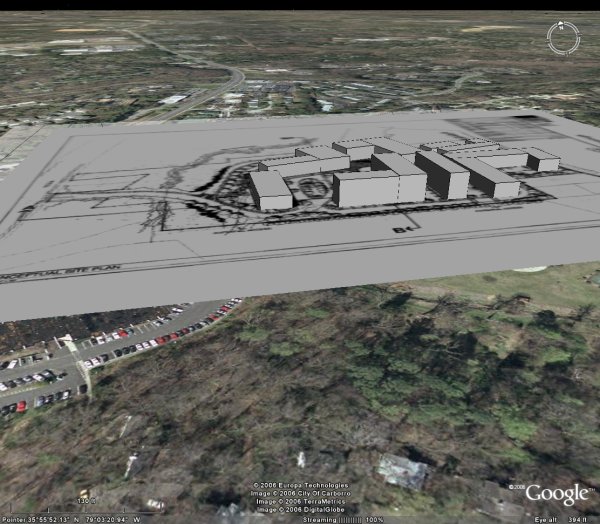Forming up across the slippery turf, the ragtag home team awaits the strong-arm tactics of a well-fortified offense. The ball is snapped. Team coverage failing, Broun dances, weaves, slips and fumbles the ball.
Timeout.
Under pressure, Coach Moeser watches the irate boosters, big-money guys, circle overhead. Yelling over the bellicose boosters’ truculent chants of “Take it to the goal,” Moeser leans forward into the huddle.
“Look boys, three points, four minutes, there’s plenty of time to turn this game around.”
As the team spreads onto the field, two heavyweight alums, Carter and Burnett, charge the bench. Sounds like they’re reminding the coach of his duty to build a grand legacy.
Responding to the barbs, the coach turns to his deep bench, looking for a solid, conservative, steady player to replace the current quarterback. “Evans. He’s got the background, the connections and, by gosh, he’s a true believer.”
Football in early August? No. Instead, unfortunately, UNC’s never-ending development games.
With the recent two-year appointment of “quarterback” Jack Evans, 10-year veteran Council-member Pat Evans’ husband and longtime Kenan-Flagler business dean, Chancellor James Moeser has signaled a troubling return to a historically failing strategy.
Moeser’s characterization of Evans’ role sets up a fake reverse. “On offense, he’ll try to help devise a plan for Carolina North that meets both university needs and community demands.”
On the other side of the ball, “Evans should be adept at reading the defense.”
Community demands? Reading the defense? A revealing and polarizing choice of words.
Centrally located, rivaling Hillsborough in scale, Carolina North is a huge project. Few residents will not feel its impact. Done right, the project could be the genesis of incredible academic and economic progress. Done wrong, our community will have a noisome blight, our taxpayer’s a terrible money pit.
Yes, Moeser is under pressure from an impatient UNC Board of Trustees. “Let’s fish or cut bait here,” as trustee Tim Burnett said in May just prior to the BOT setting an arbitrary October 2007 deadline for completing this critical phase of the process. Burnett claims he doesn’t “see how we can have the luxury of talking anymore. We’ve got to come up with a plan.”
What about UNC’s Leadership Advisory Committee? At a luxurious cost of $208,210 per year, what role does the high-stepping, hard-charging “quarterback” play? Made up of distinguished faculty, administrators, trustees, a few local elected officials and their representatives, the advisory committee has already advanced the yardstick. With the adoption of a number of key environmental, transit, financial and sustainability guiding principles as outlined by Chapel Hill’s Horace Williams Citizen’s Committee (of which I was a member), they’ve cleaved to their founding charter and taken “the first and most important step” of developing “the guiding principles for the physical development of Carolina North.”
A shame, then, that some of the trustees are falling back on the “same old, same old” pattern of conduct such as a thinly veiled threat, reminiscent of Sen. Tony Rand’s 2001 reprisal, to legislatively remove Chapel Hill’s zoning authority.
When Moeser officially announced the advisory committee’s formation, deep in December, some longtime UNC observers felt this was yet another attempt to create a false sense of community approval. “We’ve been down this road before” was a common refrain.
Yes, sometimes you need to look back to move forward. UNC’s recent handling of campus development is certainly rife with insensitivity, subterfuge and BOT upsets. Hard-won trust is easily lost. Even so, I asked folks to shed their mistrusts, start anew, and help forge a common vision of Carolina North’s future.
For most every early fumble — Chairman Ken Broun’s desire for secrecy, town’s disinterest in outside presentations, UNC’s unwillingness to field questions — there’s been incremental gains. Carolina North’s 17,000 parking spaces: off the table. Chapel Hill’s sovereign right to manage zoning: reaffirmed. A fairly thorough environmental assay, suitable for establishing a longitudinal baseline of the Horace Williams property: promised.
I’m not Chapel Hill’s defensive linebacker. I want to see a world-class Carolina North centered on “green technology.” For that, UNC’s leadership must break its habitual worldview of “us” and “them.”
Chancellor Moeser let me suggest a change of sports metaphors. Not football. Golf. Specifically, “scramble” golf.
Playing “scramble” rules, everyone is on the same team. Each player takes a stroke. The team moves on to the best shot and plays from there. Essentially, everyone contributes and excellence is reinforced.
A bit more rewarding, I believe, than butting heads.

